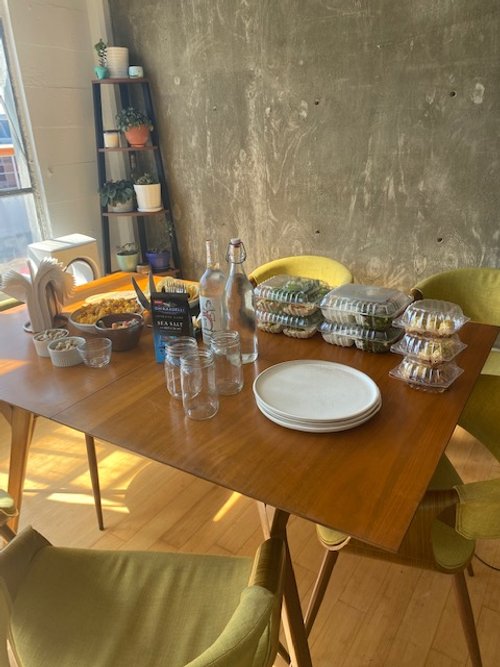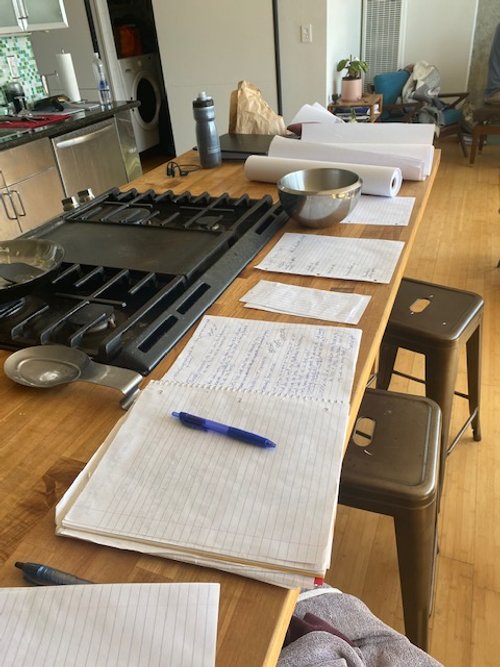Combatting time scarcity with community
The most common reason we hear why our friends don’t become donors (or our friends who are donors don’t become donor organizers) is that they don’t have the time. To read up, to meet up, to attend an event.
On the surface, this makes complete sense. Balancing the chaos of our lives - paid work, dependent care, keeping ourselves alive and healthy - the last thing we need is another to-do.
However, this doesn’t share the full story of how we want our finite time spent.
Combatting Time Scarcity with Community
We’ve had a multi-year global pandemic that has brought palpable, chronic Zoom and email fatigue. So sure, the last thing we want to do is sign up for an after-work webinar or show up to an organizing meeting that feels like a dental appointment instead of an activity we genuinely enjoy.
But it also means we desire authentic human connection to fill our emptying cups. We’ve had a multi-decade lack of investment in community spaces for the left while the right has had ample investment for their people to gather (in churches, PTA groups, and gun clubs, to name a few). Because of this, many of the people closest to us have never experienced the joy of being in a civic or political community that feels like "home."
What we’re collectively craving is being in a space that brings us hope, learning, meaning, and fun in relationship with other people who have similar values and goals to ours so that we build political power together.
Political community could be as simple as three friends meeting regularly to decide small political actions they can take, or it can be a full-fledged organization with a name, explicit roles, and concrete campaigns being built.
Mario Lugay of Justice Funders highlights that the struggle for social justice has always been a contest for people’s finite discretionary time. In particular, our discretionary time is split between:
Our consumption of goods
Our consumption of experiences like travel
Our time spent in community (civic associations, congregations, or community-based organizations)
Lugay emphasizes that in recent decades, we’ve been increasingly investing our discretionary time in consumption of goods and experiences. Meaning: most of us are lacking a sense of community.
Instead of feeling like we’re competing with our people’s lack of capacity for another “obligation,” how can we offer them a community that provides hope, learning, meaning, and fun?
4 Ways We Can Bring More Community to Our Donor Organizing Work
It can be all too easy to get caught up in short-term benefits ("doing the work" or "making an efficient use of everyone's time") that months or years later make us wonder why we're feeling depleted.
These tips help us recruit and retain lifelong donors and donor organizers.
Make strategic introductions. Donor organizing isn’t just about connecting our people to donation opportunities, it’s also about connecting people with people! At the end of each week, go through who you’ve spoken with and brainstorm people you know who might be useful for them to meet based on their interests. When you’ve introduced enough people with overlapping interests, you could have a group discussion to dive deeper. (Donor networks for high net worth individuals do this all the time, so why can't we?)
Celebrate community members’ milestones. Flip the Vote supports its members in hosting themed house party fundraisers for someone’s birthday, anniversary, or another special holiday/theme. They encourage people to incorporate photo slideshows, shoutouts, and other forms of recognition at these gatherings.
Host group socials for people to learn about each other beyond the work. Attending a social event has less barriers than attending a political event, so this can serve as a great recruitment opportunity if you encourage members to bring a friend! Groups like 31st Street and Force Multiplier have begun doing in-person outdoor potlucks. For nationally distributed organizations, event platforms like Gatheround (ideal for “speed dating”) or Toucan (useful for people to travel between different conversations) can be a more fun and interactive alternative to Zoom.
When the work must be done, make it fun! At meetings, start and end with a quick question that invites specificity while allowing people to share more about themselves (the location they're joining from, one plan they have this weekend). In emails, use Into Action Lab's open sourced memes to bring smiles and laughs. The Art of Gathering (and the author's blog) provides ample ideas on how to give more creativity and meaning to our meetings and events.
Example in Action: Donor Organizer Hub
To test out the idea if a "bare minimum political community" could be 3 friends gathering, I invited two close donor organizing pals to my apartment for a hybrid social hangout + organizing training.
We explored an issue all 3 of us had been experiencing in our donor organizing work: exhaustion from taking on more work than we can hold. While each of us are fundraising for different progressive causes, our similar pain points combined with our close relationships made sense to explore this together.
I plated some food, cherry-picked some of my favorite activities from recent trainings I've attended, and got out the butcher paper and pens.
2 key ingredients to any great brainstorm: lots of food and lots of paper!
At the beginning, we had lunch together and caught up. That's something I've missed through most organizing meetings being virtual the last few years: very few of them have us sharing meals together.
After eating, we dove into skill building exercises: one improv game role playing asker and askee to explore what courage looks like in each role, one power mapping activity to brainstorm people in our networks who can support our current donor organizing work, and a fish bowl Q&A to ask how we can bring more joy into our own work and support one another's work.
We closed the activities with spending a few minutes writing a letter to each person in the room to express our appreciation for them (for us to read when we got home, as a parting gift).
Before we concluded the trainings and went back into friendship catchup mode, we each made a vow to make one bite-sized ask to the others in the room to support our donor organizing work by end of year. From there, we'd make similar bite-sized asks to our friends not in the room to invite them to join us.
Total spent on food: $50
Total hours spent on preparation before the event: 2
Total joy felt in the room: ∞ (we'll call this initial test an initial success)
Next, I'm excited to test this out with a couple pals who aren't yet engaged in political organizing work to take a first step together: picking a cause to donate to, or finding an upcoming onboarding meeting for an organization we're interested in attending together.
What bite-sized steps can you take to transform your gathering from a to-do item to check off your list to a stepping stone in building a community?



